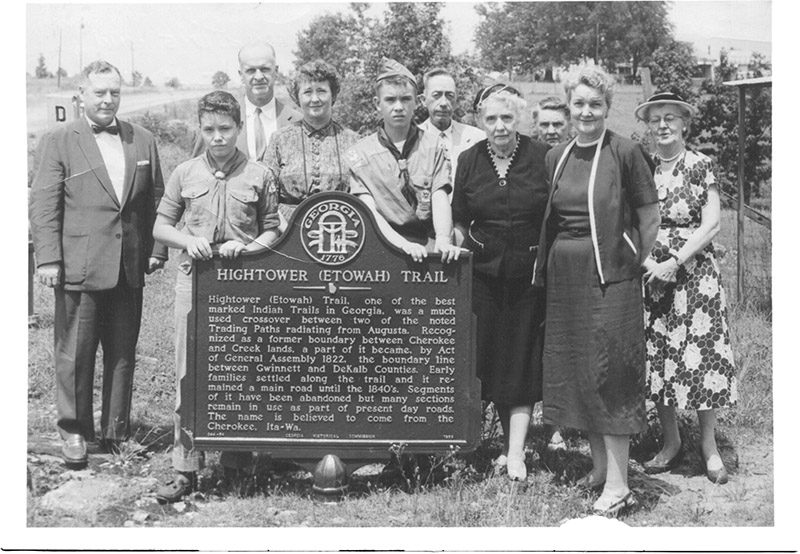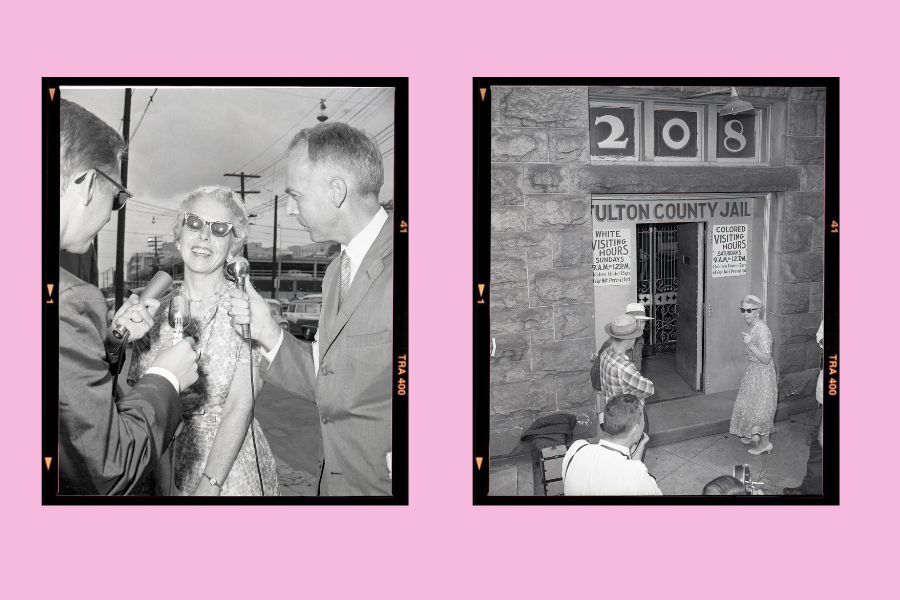Native American Trails of DeKalb County
by Maranda Perez, DHC Intern
Three main Native American trails through DeKalb County: the Hightower Trail, the Peachtree Trail, and the Sandtown Trail.

A marker for Hightower (Etowah) Trail, the most marked, and well-studied Native American trail in DeKalb County.
Before white settlers occupied today’s DeKalb County, two prominent Native American nations, the Creek and Cherokee, lived on and traveled through the area for thousands of years. These nations had a tremendous effect on the development of Georgia that largely goes unnoticed in modern day, but is nonetheless important to consider. There were three main Native American trails that ran through modern day DeKalb County: the Hightower Trail, the Peachtree Trail, and the Sandtown Trail. These trails were used by the Creek and Cherokee people for travel and trade between each other and other Native American nations in the Southeast region. These trails traced the shortest possible distances between destinations and least treacherous routes. Because of this, white settlers used these trails for themselves as wagon roads in the early settler period, and they have since become parts of prominent roads, boundaries, and rail lines in DeKalb County.

Image showing Peachtree Station located on land that once was part of Peachtree Trail.
Generally, the Native American trails followed the highest ridges, which is why many converged at Stone Mountain. Moreover, they avoided streams as much as possible, making the areas where the trails were originally established ideal points of travel even to this day. This can be seen most prevalently with how we currently use the old Peachtree Trail. Peachtree Trail connected to Sandtown Trail in Stone Mountain and ran through today’s Peachtree Road and Peachtree Street, two frequently traveled roads today. Moreover, Southern Railway followed the same path as the Peachtree Trail, and was a railroad that connected much of the Southeast. The proximity of Peachtree Trail and these areas of transportation is no coincidence. Developers of the Southern Railway sought out high ridges for the railroad. Even though the Creek and Cherokee people have since been pushed out of the area, their most important trails, being ideal points of travel, have become essential roads and railways for the county today.

Image of Decatur Station, part of Georgia Railroad, where Sandtown Trail ran through Decatur, Georgia.
Sandtown Trail makes up the part of Georgia Railroad that runs from Stone Mountain through Decatur following today’s Decatur Street to Five Points in Atlanta. It is one of few Native American land sites in Georgia that has retained its original name given by the Creek nation. The Sandtown Trail is a direct translation of the Creek Oktahasasi, and was named for the communities that the trail connected. The first community known as Sandtown was located in Alabama, and the trail ran from there to another Sandtown in Fulton County on either side of the Chattahoochee River. It can be inferred that the trail was used for trade, travel, and communication between the Sandtown communities the trail connected. Sandtown in Fulton County was known by white settlers as Buzzard Roost until 1821 when a map of the trail was drawn connecting Buzzard Roost with Sandtown in Alabama. Buzzard Roost during the time of western expansion in the nineteenth century reflected the kind of communities portrayed in old western films where both white and Native people lived together, and fought often. The trail was used frequently by white settlers travelling west to establish gold mines in parts of Georgia and Alabama where the metal was rumored to be found.
Even though all three of these Native American trails are important, the archives here at DeKalb History Center contain the most information about the Hightower Trail. The name Hightower itself is an anglicized version of Etowah, which is the name given to the trail by Native American people. Dr. John H. Goff, believed that Hightower was a corrupted version of the name caused by the language barrier between Native Americans and English settlers. Moreover, the importance of this trail was abundantly clear to residents and surveyors in 1958 of both DeKalb and Gwinnett County when they ‘lost’ the boundary between the two. The Hightower Trail determined part of the original boundary between Gwinnett County and DeKalb County. Surveyors could not definitively mark where certain parts of the trail were, leaving some residents and businesses unsure of which county they actually resided in. Surveyors had to go into the archives to review the J.T. Cunningham survey of 1819 that marked the boundary between Georgia and Creek territory during that time. This example is telling of both the importance of the Hightower Trail in DeKalb County, but also demonstrates issues that arise with a lack of documentation. There are not many sources from pre-colonial Native American nations preserved today to be researched creating a gap in knowledge that makes something as simple as finding a county line difficult.
Over the years, the people of DeKalb County have found ways to commemorate these contributions made by Creek and Cherokee people mostly by placing historic markers where the trails were located. Georgia Department of Travel placed numerous markers along the highways where many of the old trails used to be located. In 1997, a plaque was placed at the original 1822 county boundary between DeKalb and Gwinnett County to commemorate the importance of the Hightower Trail. There are innumerous ways beyond the Native American trails that the Creek and Cherokee nations affected DeKalb County, whether we are aware of it or not. However, next time you drive down Peachtree Road or hear the train passing by your work or home, perhaps you’ll remember the Native American people who lived on and used this land long before we did, and think about how their lives here continue to affect daily life here in DeKalb County now.
Works Cited
“Gwinnett, DeKalb Need Indians to Find Lost County Border”. The Atlanta Journal and Constitution, Jan. 1, 1958.
Goff, John H. “The Sandtown Trail”. Atlanta Historical Bulletin 11, no. 4 (Dec. 1966): 34-52.
Goff, John H. Summary of Remarks at DeKalb Historical Society, March 30, 1961.
Hemperley, Marion R. Historic Indian Trails of Georgia, 1989.
Hudgins, Carl T. DeKalb County Indian Trails. Jan. 22, 1951.
Martinez, Sherron. “Signs Point to the Past: DeKalb’s Indian Heritage Recalled in Highway Markers as Georgia Reacher 250th Year”. News Sun, July 20, 1983.
Moser, Charles. “Hightower Indian Trail Dedication Today”. The Atlanta Constitution, May 4, 1997.
Wells, Frank. “Not so Deep: They’ve got to Find the Hightower Trail.” Atlanta Constitution, Aug. 24, 1959.





